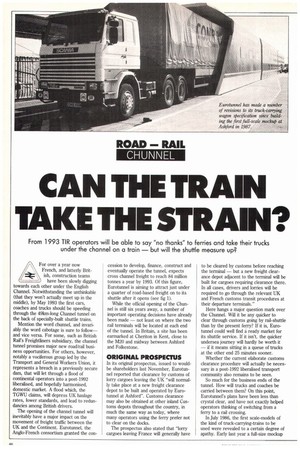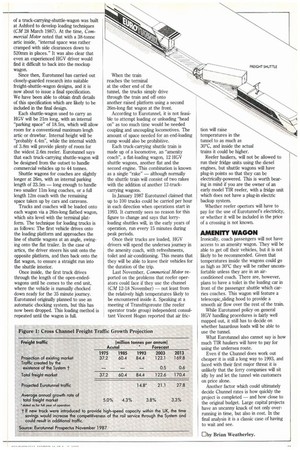CAN THE TRAIN TAKE THE STRAIN?
Page 70

Page 71

If you've noticed an error in this article please click here to report it so we can fix it.
From 1993 TIR operators will be able to say "no thanks" to ferries and take their trucks under the channel on a train — but will the shuttle measure up?
For over a year now French, and latterly British, construction teams have been slowly digging towards each other under the English Channel. Notwithstanding the unthinkable (that they won't actually meet up in the middle), by May 1993 the first cars, coaches and trucks should be speeding through the 491cm-long Channel tunnel on the back of specially-built shuttle trains.
Mention the word chunnel, and invariably the word cabotage is sure to follow— and vice versa. For some, such as British Rail's Freightliners subsidiary, the channel tunnel promises major new road/rail business opportunities. For others, however, notably a vociferous group led by the Transport and General Workers Union, it represents a breach in a previously secure dam, that will let through a flood of continental operators into a post-1992 liberalised, and hopefully harmonised, domestic market. A flood which, the TGWU claims, will depress UK haulage rates, lower standards, and lead to redundancies among British drivers.
The opening of the channel tunnel will inevitably have a major impact on the movement of freight traffic between the UK and the Continent. Eurotunnel, the Anglo-French consortium granted the con cession to develop, finance, construct and eventually operate the tunnel, expects cross channel freight to reach 84 million tonnes a year by 1993. Of this figure, Eurotunnel is aiming to attract just under a quarter of road-based freight on to its shuttle after it opens (see fig 1).
While the official opening of the Chunnel is still six years away, a number of important operating decisions have already been made — not least on where the two rail terminals will be located at each end of the tunnel. In Britain, a site has been earmarked at Cheriton in Kent, close to the M20 and midway between Ashford and Folkestone.
ORIGINAL PROSPECTUS
In its original prospectus, issued to wouldbe shareholders last November, Eurotunnel reported that clearance by customs of lorry cargoes leaving the UK "will normally take place at a new freight clearance depot to be built and operated by Eurotunnel at Ashford". Customs clearance may also be obtained at other inland Customs depots throughout the country, in much the same way as today, where many operators using the ferry prefer not to clear on the docks.
The prospectus also stated that "lorry cargoes leaving France will generally have to be cleared by customs before reaching the terminal — but a new freight clearance depot adjacent to the terminal will be built for cargoes requiring clearance there. In all cases, drivers and lorries will be required to go through the relevant UK and French customs transit procedures at their departure terminals."
Here hangs a major question mark over the Chunnel. Will it be any quicker to clear through customs going by rail-shuttle than by the present ferry? If it is, Eurotunnel could well find a ready market for its shuttle service. If it isn't, the quicker undersea journey will hardly be worth it — if it means sitting in a queue of trucks at the other end 25 minutes sooner.
Whether the current elaborate customs clearance procedure will actually be necessary in a post-1992 liberalised transport community also remains to be seen.
So much for the business ends of the tunnel. How will trucks and coaches be carried between them? On this point, Eurotunnel's plans have been less than crystal clear, and have not exactly helped operators thinking of switching from a ferry to a rail crossing.
In July 1986, the first scale-models of the kind of truck-carrying-trains to be used were revealed to a certain degree of apathy. Early last year a full-size mockup of a truck-carrying-shuttle-wagon was built at Ashford to develop loading techniques (CM 28 March 1987). At the time, Commercial Motor noted that with a 38-tonne artic inside, "internal space was rather cramped with side clearances down to 520mm in places." It was also clear that even an experienced HGV driver would find it difficult to back into the mockup wagon.
Since then, Eurotunnel has carried out closely-guarded research into suitable freight-shuttle-wagon designs, and it is now about to issue a final specification. We have been able to obtain draft details of this specification which are likely to be included in the final design.
Each shuttle-wagon used to carry an HGV will be 21m long, with an internal "parking space" of 18.5m, which will allow room for a conventional maximum lengh artic or drawbar. Internal height will be "probably 4.4m", while the internal width of 3.8m will provide plenty of room for the widest 2.6m reefer. Eurotunnel says that each truck-carrying shuttle-wagon will be designed from the outset to handle commercial vehicles up to 44 tonnes.
Shuttle wagons for coaches are slightly longer at 26m, with an internal parking length of 23.5m — long enough to handle two smaller llrn long coaches, or a full length 12m coach with the remaining space taken up by cars and caravans.
Trucks and coaches will be loaded onto each wagon via a 26m-long flatbed wagon, which sits level with the terminal platform. The technique for loading trucks is as follows: The first vehicle drives onto the loading platform and approaches the line of shuttle wagons at an angle, swinging onto the flat trailer. In the case of artics, the driver steers his unit onto the opposite platform, and then back onto the flat wagon, to ensure a straight run into the shuttle interior.
Once inside, the first truck drives through the length of the open-endedwagons until he comes to the end unit, where the vehicle is manually chocked down ready for the 35 minute journey. Eurotunnel originally planned to use an automatic chocking system, but this has now been dropped. This loading method is repeated until the wagon is full. When the train reaches the terminal at the other end of the tunnel, the trucks simply drive through the train and off onto another raised platform using a second 26m-long flat wagon at the front.
According to Eurotunnel, it is not feasible to attempt loading or unloading "head on" as too much time would be needed coupling and uncoupling locomotives. The amount of space needed for an end-loading ramp would also be prohibitive.
Each truck-carrying shuttle train is made up of a locomotive, an "amenity coach", a flat-loading wagon, 12 HGV shuttle wagons, another flat and the second engine. This combination is known as a single "rake" — although normally the shuttle train will consist of two rakes with the addition of another 12-truckcarrying wagons.
In January 1987 Eurotunnel claimed that up to 100 trucks could be carried per hour in each direction when operations start in 1993. It currently sees no reason for this figure to change and says that lorryloading shuttles will, in the early years of operation, run every 15 minutes during peak periods.
Once their trucks are loaded, HGV drivers will spend the undersea journey in the amenity coach, with refreshments, toilet and air-conditioning. This means that they will be able to leave their vehicles for the duration of the trip.
Last November, Commerical Motor reported on the problems that reefer operators could face if they use the chunnel (CM 12-18 November) — not least from the relatively high temperatures likely to be encountered inside it. Speaking at a meeting of Transfrigoroute (the reefer operator trade group) independent consultant Vincent Hogan reported that air fric
tion will raise temperatures in the tunnel to as much as 30°C, and inside the actual trains it could be higher.
Reefer hauliers, will not be allowed to run their fridge units using the diesel engines, but shuttle wagons will have plug-in points so that they can be electrically-powered. This is worth bearing in mind if you are the owner of an early model TIR reefer, with a fridge unit which does not have a plug-in electric backup system.
Whether reefer opertors will have to pay for the use of Eurotunnel's electricity, or whether it will be included in the price of a crossing is not known.
AMENITY WAGON
Ironically, coach passengers will not have access to an amenity wagon. They will be able to get off their vehicles, but it is not likely to be recommended. Given that temperatures inside the wagons could go as high as 305C they will be rather uncomfortable unless they are in an airconditioned coach. There are, however, plans to have a toilet in the loading car in front of the passenger shuttle which carries coaches. This wagon will feature a telescopic,,sliding hood to provide a smooth air flow over the rest of the train.
While Eurotunnel policy on general HGV handling procedures is fairly well mapped out, it still has to decide on whether hazardous loads will be able to use the tunnel.
What Eurotunnel also cannot say is how much TIR hauliers will have to pay for using the undersea route.
Even if the Chunnel does work out cheaper it is still a long way to 1993, and faced with their first major threat it is unlikely that the ferry companies will sit idly by and let the tunnel win customers on price alone.
Another factor which could ultimately decide Chunnel rates is how quickly the project is completed — and how close to the original budget. Large capital projects have an uncanny knack of not only overrunning in time, but also in cost In the final analysis it is a classic case of having to wait and see.
















































































































